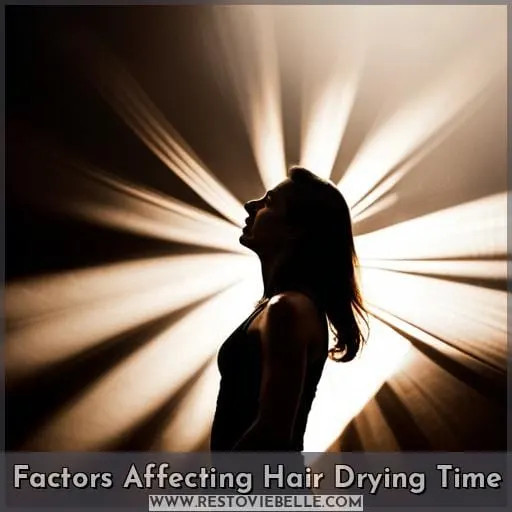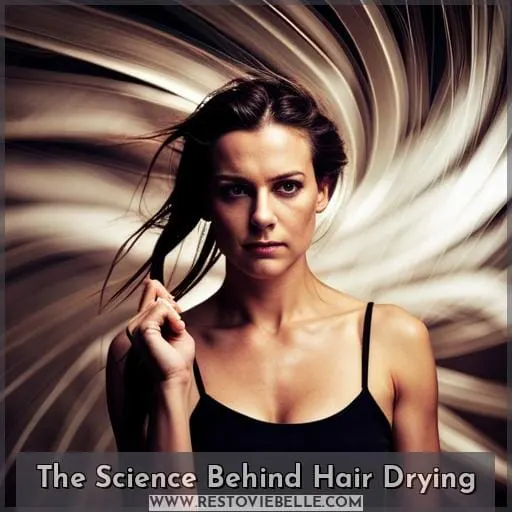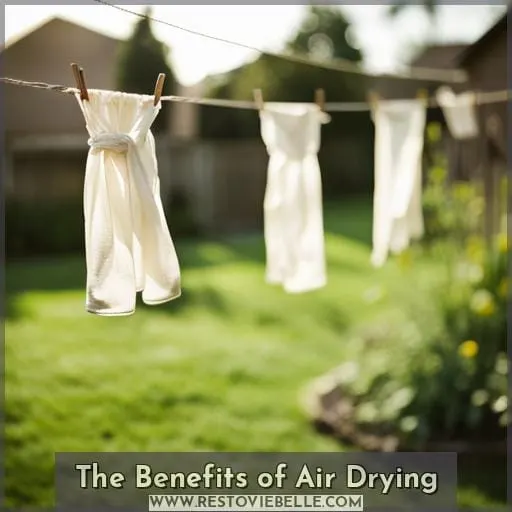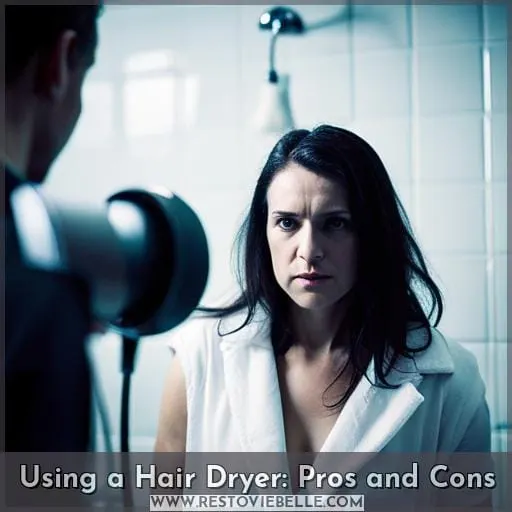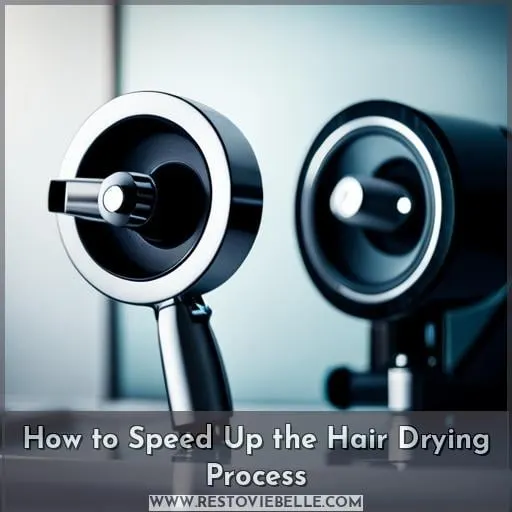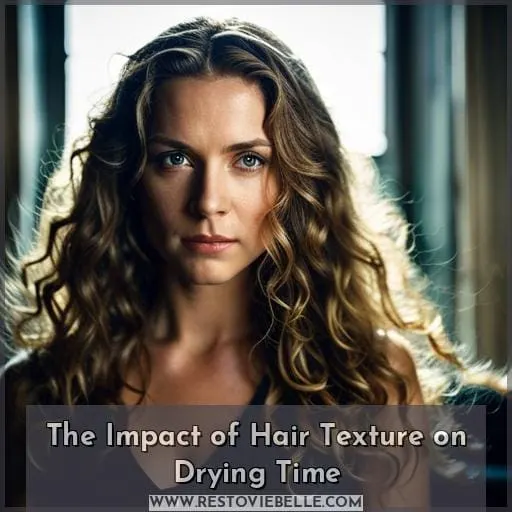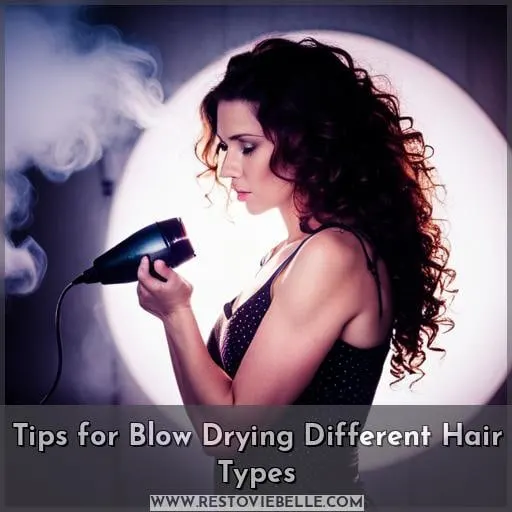This site is supported by our readers. We may earn a commission, at no cost to you, if you purchase through links.
 Curious about how long it takes for hair to dry? It’s a question we’ve all asked ourselves at least once, and the answer may surprise you. Not only does the duration of drying depend on factors like porosity, length, and wetness of your tresses – but mastering the art of blow-drying can be essential for healthy-looking hair while getting out that door in time.
Curious about how long it takes for hair to dry? It’s a question we’ve all asked ourselves at least once, and the answer may surprise you. Not only does the duration of drying depend on factors like porosity, length, and wetness of your tresses – but mastering the art of blow-drying can be essential for healthy-looking hair while getting out that door in time.
Table Of Contents
- Key Takeaways
- Factors Affecting Hair Drying Time
- The Science Behind Hair Drying
- How Does Towel Drying Affect Hair Drying Time?
- The Benefits of Air Drying
- Using a Hair Dryer: Pros and Cons
- How to Speed Up the Hair Drying Process
- Hair Plopping: What is It and How Does It Help?
- The Impact of Hair Texture on Drying Time
- Tips for Blow Drying Different Hair Types
- Conclusion
Key Takeaways
- Factors affecting hair drying time: porosity, length, wetness.
- Choosing the right tools and products minimizes drying time.
- Different hair types require different drying techniques.
- Proper knowledge and technique preserve the health and beauty of hair.
Factors Affecting Hair Drying Time
The time it takes for hair to dry can vary greatly depending on a number of factors, including the porosity and type of your hair, how wet it is when you start drying, humidity levels in the air, and even the length.
All these components come together to determine just how long you’ll need to spend blow-drying or air-drying your locks before they’re ready for styling.
Hair Porosity and Type
Your hair’s porosity and type can make a big difference in how quickly it dries, so be sure to use the right conditioning and styling products for your specific needs. High porosity hair absorbs more moisture but also loses it faster. Low porosity tends to require more heat or longer drying times.
Natural hair typically has higher levels of sebum that helps keep strands hydrated throughout the day, resulting in quicker drying time with air or towel-drying techniques than other types of hair. For all types, using a combination of air-drying and blow-drying is recommended for minimizing damage while still getting desired results.
- Use microfiber towels or t-shirts to reduce frizz
- Apply conditioners with silicones for water repellency
- Include hydrating shampoo & conditioner
- Choose styling tools & products carefully
- Utilize overnight masks & leave-in conditioners
By following these steps, you can achieve faster drying times without compromising on style!
Wetness of the Hair
Soaking wet hair will take longer to dry than slightly damp hair, just like a soggy sponge takes time to absorb all its moisture. The wetness of your hair is one of the biggest factors that can affect the drying time and how healthy your mane remains.
To minimize damage from heat styling tools or air-drying, it’s important to towel-dry as much water out first without being too rough on the strands. For best results, use a microfiber towel and t-shirt for absorbing excess moisture before you start blow drying and styling with heated tools.
Humidity Levels
The humidity in your environment can drastically affect how quickly your hair dries. High humidity levels often lead to frizzy hair, as the moisture absorption rate is much higher when it’s humid. This results in longer drying times for air-drying and blow-drying techniques, since more time is needed to evaporate the excess water from each strand of hair.
Additionally, increased heat damage may occur due to prolonged use of a hairdryer or other styling tools at high temperatures that are necessary with longer drying times.
Length of the Hair
No matter how quickly you work, your hair’s drying time is directly affected by its length – the longer it is, the more attention it needs! Short hair can often be air-dried or towel-dried relatively quickly.
However, long hair will require special techniques to prevent damage during drying and styling.
To help quicken up drying time without compromising on the quality of style, use a blow dryer with cool air settings at regular intervals. While brushing and sectioning the hair, use the blow dryer until it is mostly dry.
For those with curly or wavy textures that need extra care when styling after washing their locks, they should try out ‘hair plopping’ – an innovative way to let your tresses naturally form a shape.
The Science Behind Hair Drying
Have you ever wondered how long it takes for your hair to dry? From the role of the cuticle, evaporation, and airflow, there are several scientific aspects that affect hair drying time. The composition of a person’s individual strands plays an integral part in how quickly or slowly their locks will reach optimum dryness.
The Role of the Hair Cuticle
Understanding the role of your hair’s cuticle can help you determine how to best dry it and avoid damaging heat styling tools.
When these layers are sealed shut, they retain more water during drying, resulting in reduced drying time. You can also use sealing techniques such as blow-drying with cold air or using conditioner with silicones to lock in moisture while protecting against heat damage.
Ultimately, understanding how your hair’s cuticles work will allow you to maximize its potential without compromising its health!
Evaporation and Airflow
You can speed up the drying process by allowing evaporation and airflow to work their magic! Hair drying techniques, such as towel absorption and blow-drying with a brush for maximum efficiency, or plopping curly hair into shape, all help move things along.
For optimal results, consider using hydrated products in combination with heat styling tools while also using air dryers on low settings. While it may take longer for thick or long hair to completely dry compared to fine and short styles, proper use of these techniques will significantly reduce drying time.
By combining effective evaporation methods with efficient airflow strategies, you’ll be able to maximize your style potential without compromising on time!
How Does Towel Drying Affect Hair Drying Time?
By towel drying your hair, you can reduce the amount of time it takes to air dry and style. Towel drying techniques, such as blotting or gently squeezing with a hair towel, are effective in removing excess water from strands while preserving their structure and condition.
Hair towels absorb more moisture than t-shirts or microfiber cloths, making them ideal for quickening the air drying process without causing damage.
Using additional products like leave-in conditioners and styling creams can also improve efficiency by providing protection against humidity levels and improving manageability during blowdrying.
When used properly, towels offer several benefits. They prevent breakage caused by tugging on wet locks, evenly distribute heat during blowdrying, create volume when wrapped around sections before applying warm air, and protect ends from tangling while still allowing for movement throughout each strand’s length.
Here are some tips for optimal results:
- Blot excess water onto damp strands instead of rubbing vigorously.
- Use an appropriate size/thickness towel depending on your hair type.
- Avoid wringing out curls, as it can cause frizziness.
Towel-drying correctly helps preserve natural hydration levels, so you don’t have to worry about sacrificing shine or softness during styling sessions any longer!
The Benefits of Air Drying
Air drying is an ideal way to dry your hair while keeping it healthy and avoiding damage from heat styling. With the right techniques, you can reduce air drying time while still protecting your locks, allowing for a quick and easy style that looks great.
Hair Health and Damage Prevention
To keep your hair healthy and avoid damage, it’s important to consider the right tools, products, and techniques when blow-drying. Like a soothing salve for stressed strands, heat styling can be damaging if not done properly.
Invest in high-quality hairdryers that have multiple speed/heat settings to reduce the risk of heat damage while still getting quick results. Use moisturizing shampoos and conditioners along with leave-in treatments or overnight masks to help lock in moisture before drying your hair.
When you do need to dry quickly using a hot tool, such as a curling iron, make sure you protect your locks by applying a thermal protector beforehand! By following these tips on how to best care for your precious mane during blow-drying sessions, you’ll be able to get beautiful tresses without compromising their health!
Tips for Quicker Air Drying
Exploring ways to reduce air drying time can help you keep your hair healthy while still achieving the desired look. To prevent frizz, choose a hydrating shampoo and conditioner that’ll add moisture and reduce static.
Use a microfiber towel or t-shirt to absorb water from the strands instead of rubbing it in with regular towels.
Invest in styling products specially designed for air drying, like leave-in conditioners or overnight masks that provide nourishment without using heat tools. Additionally, use a diffuser attachment on your blow dryer and a round brush to create volume if needed, without subjecting your hair to high temperature damage.
Finally, always finish off with hairspray after styling so your look stays intact all day long!
Using a Hair Dryer: Pros and Cons
Using a hair dryer is an effective way to quickly dry your hair, but the heat and speed of air coming from the blow dryer can damage delicate strands if you’re not careful. It’s important to understand how different types of blow drying techniques work for each type of hair, as well as using proper heat protectant products while styling with a hair dryer.
It takes longer to achieve fullness and volume when air drying without any tools compared to using hot or cold air from a hair dryer. Yet, it’s best practice for avoiding unnecessary damage caused by too much direct heat exposure on fragile tresses.
The most important thing is finding balance between repeated hot tool usage and allowing your mane some time away from all forms of artificial heating elements so that it may rejuvenate itself after every session.
How to Speed Up the Hair Drying Process
If you’re looking to speed up the hair drying process, there are a few easy steps that can help. Firstly, using a microfiber towel or t-shirt is an effective way of absorbing excess water and reducing the time spent blow-drying.
Applying products such as conditioners with silicones for water repellency can also increase the speed of drying while providing heat protection from styling tools.
Using a Microfiber Towel
Wrapping your hair in a microfiber towel after showering can help speed up the drying process, creating soft and smooth locks without sacrificing time. Microfiber towels are highly absorbent and gentle on delicate strands, making them an ideal choice for those looking to dry their hair quickly.
Plus, using this type of towel is more eco-friendly than regular cotton towels, which require lots of water during manufacturing.
To get the most out of your drying session with a microfiber towel, use light pressure when blotting wet areas. Wrap it around sections or all over your head, and avoid rubbing as this causes friction that damages cuticles.
Applying Hair Products for Faster Drying
Boosting your blow-drying routine with the right products can be like adding rocket fuel to a car – propelling you toward glossy, sleek hair in record time. Pre-blowdry products, such as heat protectants and blow dry creams, help create a protective barrier between your hair and heat styling tools.
Fast-drying sprays or thermal sprays are perfect for creating smoothness without weighing down fine hair textures. Apply product before blow-drying short hair to make it more manageable when working with smaller sections of damp locks.
Preparing with product allows you to maximize the effectiveness of each stroke while controlling flyaways, adding volume, taming frizzes, and eliminating static electricity from strands all at once! With these essential items in hand, plus some patience, achieving that salon blow look is now within reach – minus all those hefty price tags too!
Proper Blow Drying Techniques
Get your blow drying game on-point with the right techniques for different hair types and lengths! To speed up the process, use a heat protection product before you start.
Try using a combination of air drying and blow drying to reduce time spent under the dryer. Take advantage of volumizing techniques when styling shorter locks, while longer styles require more patience as they take longer to dry.
Use low heat settings and high speeds if possible or cool blasts at the end for extra shine. This will also help lock in volume or curl definition from any styling products used prior.
Finally, avoid overblow-drying, which can damage your hair. Know when it’s time to stop so that you don’t harm those locks!
Hair Plopping: What is It and How Does It Help?
Plopping your hair can help you dry it faster and achieve a long-lasting style. It’s an easy technique that requires no heat or tools and provides several benefits:
- Plopping allows moisture to be absorbed more evenly throughout the strands of hair, leaving less time for drying.
- This method helps preserve curls’ shape while they dry without having to touch them with a brush or comb, which could lead to frizziness.
- Hair plopping also adds volume by allowing the roots of your locks to stand up naturally as they air-dry instead of being weighed down against the head like other methods do.
- Lastly, this technique is especially beneficial for those with long hair because it prevents tangles from forming in wet strands that would otherwise occur if left unsecured during traditional air drying methods such as towel wrapping or bunning techniques.
By taking only minutes out of your routine to secure damp strands into place before letting them dry freely, any type of curl pattern will benefit from plopping! All you need is an old t-shirt – lay it flat on the top surface, then wrap wet sections around until all are tucked away securely inside fabric folds – sit back and let nature take its course! With consistent use over time, you’ll find yourself enjoying fewer bad hair days due to the longevity achieved through improved hydration levels maintained by protecting curls while using this simple yet effective way of styling.
The Impact of Hair Texture on Drying Time
Time flies when you understand how your hair texture affects the drying time of your locks.
Porosity testing is important for gauging how quickly or slowly moisture will evaporate from each strand. Humidity also plays a role in altering drying times, making it hard to predict accurately.
Thicker, denser hair typically takes longer than finer strands, while curly or wavy textures may need additional styling products to reduce frizz and speed up air-drying.
Blow-drying versus air-drying is another factor that must be taken into consideration. Blow dryers can cut down on time, but at the expense of heat damage if not used correctly with proper attachments and low-temperature setting controls.
Hair hacks like plopping help preserve curls by reducing friction during towel absorbance, while conditioners containing silicones are great for repelling water droplets, aiding in faster absorption rates no matter what type of tresses you possess!
Tips for Blow Drying Different Hair Types
Blow-drying is an important part of hair care, and it takes extra attention to get the best results depending on your hair type. Straight, curly, natural, thick, or short – each texture requires a different approach for optimal drying time.
Understanding techniques that suit your particular style can be key in creating beautiful hairstyles without damage caused by overuse of heat styling tools.
Straight Hair
Blow-drying straight hair is a breeze when you use the right tools and techniques! With heat protectants, styling products, and blow-drying methods tailored to your locks, you can achieve salon-worthy results in no time.
Start off by sectioning your hair for an even dry. Use round brushes or flat paddles to smooth and polish each strand as it dries. If you have long tresses, blow dry from root to tip until completely dried before moving on.
Don’t forget those finishing touches—add texture spray or shine serum once done for an extra glamorous look that will last all day!
Curly Hair
For those with curly hair, embracing the natural texture is key to creating a lasting style without any heat damage. Hair plopping – wrapping damp locks in a soft towel or t-shirt – is an effective way to dry curls while preserving their shape.
Apply leave-in conditioner after washing and detangle using your fingers or a wide-tooth comb before beginning the drying process.
Finish off styling by sectioning out hair with clips if styling needs more precision, like adding volume toward roots near deep side parts.
Natural Hair
When blow-drying natural hair, it’s important to use a hydrating shampoo and conditioner to maintain moisture and avoid damage.
To reduce shrinkage, opt for protective styles like braids or twists.
Detangling methods should be gentle yet effective; finger detangling is often the easiest way for those with kinky coils.
Moisture retention is key – look for products that nourish the scalp while providing lightweight hydration throughout your strands.
When blow drying natural hair, keep in mind that heat tends to dry out delicate textures quickly so always apply heat on low settings!
For extra lift and volume at the roots of your style, try using a diffuser attachment on your blow dryer instead of direct heat from above when styling curls or waves.
With proper care, you can achieve beautiful results without sacrificing health!
Thick Hair
If you’ve got thick hair, blow drying can be a bit of a challenge – it takes longer and requires more care. To make the process easier, section your hair with clips before starting and use a big round brush for styling while blow drying.
When using the dryer, keep it at least 6 inches from your scalp to avoid heat damage and focus on less heat but more speed instead! You may also want to invest in products that contain silicones for added water repellency so that you shorten the time spent blowing out each section of hair.
With patience and practice, these tips will help you get sleek locks in no time!
Short Hair
With short hair, you can achieve a fast and flawless blow-dry in no time! To avoid damage to your tresses, use the right tools: a round brush for volume, a microfiber towel or T-shirt to reduce friction, and a styling product such as mousse for hold.
Invest in heat protectant products and conditioners with silicones that will help repel water.
Blow dry on low heat settings while using a comb attachment to direct airflow where needed. When nearly finished, switch off the dryer and add texture by scrunching sections of damp hair with your hands before letting it completely air-dry.
Don’t rush through this process. Take time to style each section evenly so you’ll end up with a textured lived-in finish!
Conclusion
Striking a balance between air drying and blow-drying is key to achieving healthy, beautiful locks. With a keen eye on the factors affecting drying time, such as hair type and length, porosity, humidity, and wetness, you can speed up the process with the help of microfiber towels, hair products, and proper blow-drying techniques.
Hair plopping offers a unique way to dry curly hair, while the texture of your hair can also affect drying time. Ultimately, how long it takes for your hair to dry depends on the time and effort you put into it.
With the right knowledge and technique, you can master the art of drying your hair in a way that preserves its health and beauty.

